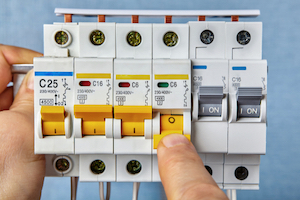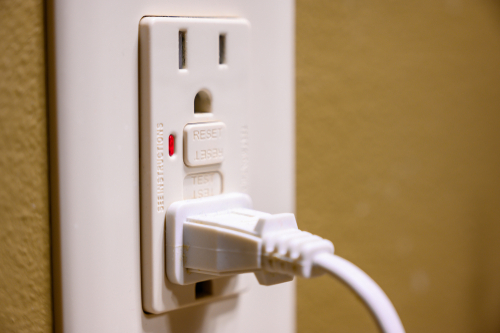How To Troubleshoot and Reset a Tripped Circuit Breaker

Figure 1: Turning on a circuit breaker on a control panel after it tripped due to overload.
Circuit breakers trip to protect against overloading and short circuits, but this interruption in the electricity supply can be inconvenient. Therefore, it’s helpful to know why the circuit breaker tripped so the issue can be resolved as soon as possible. This article covers various issues that lead to circuit breaker tripping, why, and possible solutions.
Table of contents
- What is a circuit breaker?
- Safety considerations
- How to reset a circuit breaker
- Other circuit breaker issues
- Summary
- FAQs
View our online selection of circuit breakers!
What is a circuit breaker?
A circuit breaker protects electrical systems from damage due to abnormal electrical conditions, such as overcurrents, short circuits, and faults. It consists of a trip unit that detects the fault, a mechanical mechanism that opens the contacts, and an arc quenching system that extinguishes the arc generated during current interruption. Once the fault is cleared, the circuit breaker can be reset, allowing normal operation to resume.
Safety considerations
The most common reason a circuit breaker trips is due to an overload in that circuit (see next section). If there is any indication of a different issue, it is highly recommended to hire a professional electrician to inspect and repair the circuit breaker. Making a mistake when working with electricity can be fatal.
How to reset a circuit breaker
Follow these steps to reset an individual circuit breaker:
- Locate the circuit breaker panel in the building. It might be in the basement, garage, or utility closet. Breakers in the panel should all be labeled to clearly show which breakers control power to which rooms in the building.
- Determine which circuit breaker tripped. The tripped breaker’s switch will be in the opposite direction than all the other breakers’ switches.
- Flip the switch to restore power. If it trips again, unplug all of the appliances connected to the circuit then flip the switch again.
- Slowly plug appliances back into the circuit to determine which appliance is overloading the circuit.
- Some appliances run automatically (e.g., a fridge). For appliances that don’t turn on automatically, turn them on to test whether or not they overload the circuit.
Reset the main circuit breaker
In the case of a complete power outage, first, check if nearby buildings still have power. If they do, try to restore electricity by resetting the main circuit breaker. The main circuit breaker connects power to the entire circuit breaker panel, in other words, it controls power to the entire building. In the circuit breaker panel, the main breaker is the largest circuit breaker and is likely labeled “Main.” If it is not located in the breaker panel, the main circuit breaker is probably outside, next to the electricity meters.
- Switch off all the circuits in the breaker panel.
- Switch the main circuit breaker on and off two times.
- Return to the circuit breaker panel and switch all the circuit breakers back on.
If the power does not return to the building, contact an electrician.
Other circuit breaker issues
Circuit breakers encounter other issues beyond overloading. In most situations, it’s advisable to get help from a professional electrician, as mentioned above.
The circuit breaker is buzzing
A circuit breaker buzzing under load can be a normal situation or a critical situation. It’s normal for circuit breakers to hum softly due to electricity passing through them. If there is a concern, pay attention to the buzzing sound to determine whether it gets louder. If it doesn’t, there is no issue.
If the buzzing sound is medium to high, the circuit breaker is overloaded but hasn’t tripped. If there is a sizzling sound, there are arcs of electricity occurring due to loose circuits. Both situations are dangerous and may lead to a fire or electrical damage.
The circuit breaker is getting hot and trips
A circuit breaker should not exceed 60 °C (140 °F). The temperature is OK if plastic components can be touched without burning the finger. Reasons why a circuit breaker overheats are:
- Loose connections: Electrical resistance increases with loose connections, raising the temperature.
- Current limit: The current may be just below the tripping level. If this occurs for a long time, the breaker can heat up to dangerous levels.
- Bad breaker: The breaker may have broken and needs to be replaced.
The circuit breaker didn’t trip but there is no power
Sometimes when the circuit breaker trips, the switch only moves slightly instead of moving all the way to the off position. This makes it seem that the breaker didn’t trip. Try resetting the breaker anyway.
Newer homes have outlets with ground fault circuit interrupters (GFCI) (Figure 2). Try to return power by pushing the reset button on the outlet. In some older homes, outlet circuits are in a line, so if one outlet has issues, it can cause issues with all of the other outlets. Finally, of course, the breaker did not trip because it is broken.

Figure 2: An outlet with a ground fault circuit interrupter
The tripped circuit breaker will not reset
The usual reason why a circuit breaker does not reset is that it is still overloaded. Unplug all the appliances connected to the circuit and try again to reset it. If this does not solve the situation, there might be a short circuit. This means the hot wire connected to the breaker is touching the neutral wire. The breaker trips as a safety mechanism in this case.
Another reason why circuit breakers keep tripping can be a ground fault. A hot wire is touching a bare ground wire or metal component of an appliance or equipment. Ground faults are very dangerous in wet environments, such as a kitchen or bathroom.
Summary
The most common reason a circuit breaker trips is because it is overloaded. This is solved by unplugging the appliances from the circuit and resetting the switch. If this doesn’t work, contacting an electrician is highly recommended to avoid danger. Before deciding to replace one, read our guide on how to replace a circuit breaker.
FAQs
How do I find what is tripping my circuit breaker?
If a circuit is overloaded, unplug all appliances connected to the circuit. After a few minutes, plug back in the appliances one at a time until the circuit breaker trips again.
Should a circuit breaker be immediately reset?
Immediately reset a tripped circuit breaker only if it’s certain that the issue is overloading. If it’s not certain, consider contacting a licensed electrician to identify the issue.
What to do if the main circuit breaker keeps tripping?
Look for overloaded circuits, malfunctioning appliances, and whether the breaker itself is defective. Try resetting the breaker and if it continues to trip, contact an electrician.





